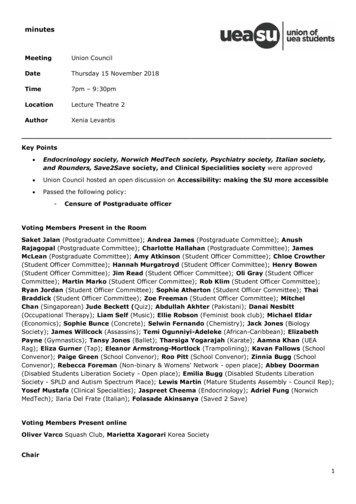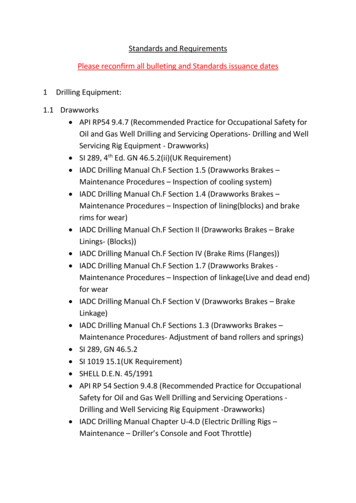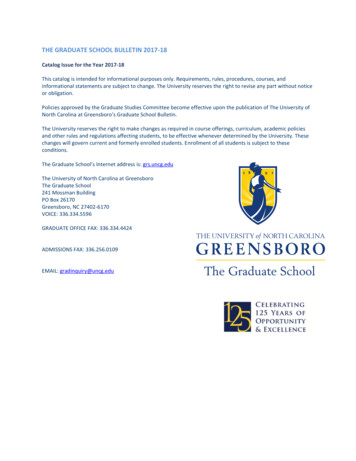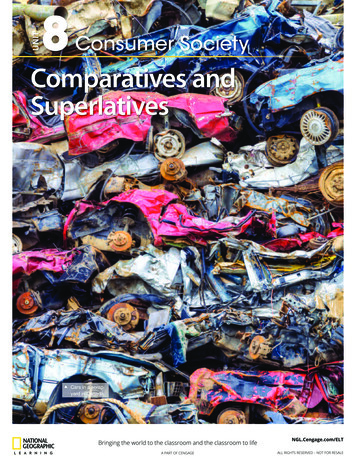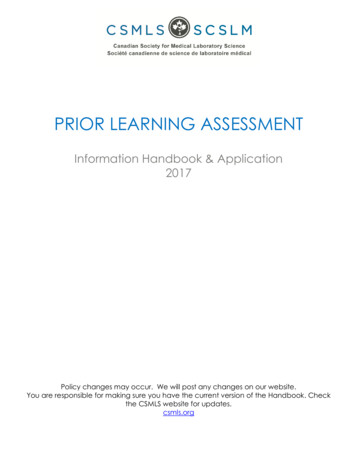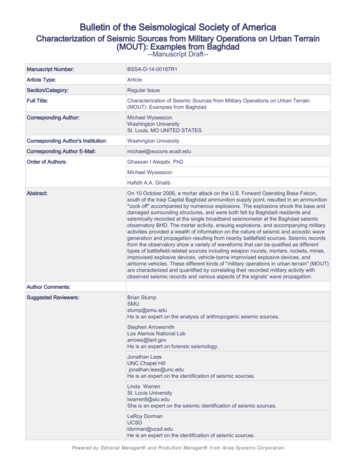
Transcription
Bulletin of the Seismological Society of AmericaCharacterization of Seismic Sources from Military Operations on Urban Terrain(MOUT): Examples from Baghdad--Manuscript Draft-Manuscript Number:BSSA-D-14-00187R1Article Type:ArticleSection/Category:Regular IssueFull Title:Characterization of Seismic Sources from Military Operations on Urban Terrain(MOUT): Examples from BaghdadCorresponding Author:Michael WysessionWashington UniversitySt. Louis, MO UNITED STATESCorresponding Author's Institution:Washington UniversityCorresponding Author E-Mail:michael@wucore.wustl.eduOrder of Authors:Ghassan I Aleqabi, PhDMichael WysessionHafidh A.A. GhalibAbstract:On 10 October 2006, a mortar attack on the U.S. Forward Operating Base Falcon,south of the Iraqi Capital Baghdad ammunition supply point, resulted in an ammunition"cook off" accompanied by numerous explosions. The explosions shook the base anddamaged surrounding structures, and were both felt by Baghdadi residents andseismically recorded at the single broadband seismometer at the Baghdad seismicobservatory BHD. The mortar activity, ensuing explosions, and accompanying militaryactivities provided a wealth of information on the nature of seismic and acoustic wavegeneration and propagation resulting from nearby battlefield sources. Seismic recordsfrom the observatory show a variety of waveforms that can be qualified as differenttypes of battlefield-related sources including weapon rounds, mortars, rockets, mines,improvised explosive devices, vehicle-borne improvised explosive devices, andairborne vehicles. These different kinds of "military operations in urban terrain" (MOUT)are characterized and quantified by correlating their recorded military activity withobserved seismic records and various aspects of the signals' wave propagation.Author Comments:Suggested Reviewers:Brian StumpSMUstump@smu.eduHe is an expert on the analysis of anthropogenic seismic sources.Stephen ArrowsmithLos Alamos National Labarrows@lanl.govHe is an expert on forensic seismology.Jonathan LeesUNC Chapel Hilljonathan.lees@unc.eduHe is an expert on the identification of seismic sources.Linda WarrenSt. Louis Universitylwarren8@slu.eduShe is an expert on the seismic identification of seismic sources.LeRoy DormanUCSDldorman@ucsd.eduHe is an expert on the identification of seismic sources.Powered by Editorial Manager and ProduXion Manager from Aries Systems Corporation
Opposed Reviewers:Response to Reviewers:Both a "Response to Reviews" and "Annotated Manuscript" will be attached.Powered by Editorial Manager and ProduXion Manager from Aries Systems Corporation
Letter to EditorClick here to download Letter to Editor: CoverLetter 3.docDepartment ofEarth and Planetary SciencesApril 20, 2015Dr. Diane DoserEditor, BSSASeismological Society of America400 Evelyn Ave., Suite 201Albany, CA 94706-1375Dear Dr. Doser,Please accept this revised manuscript for submission to BSSA entitled “Characterization ofSeismic Sources from Military Operations on Urban Terrain (MOUT): Examples fromBaghdad,” by Ghassan I. Aleqabi, Michael E. Wysession, and Hafidh A. A. Ghalib. Thank youfor sending us the reviews, which were extremely helpful in stimulating a major revision of ourmanuscript. An annotated manuscript and detailed response to comments are included here.Sincerely,Michael WysessionDepartment of Earth and Planetary SciencesCampus Box 1169Washington UniversitySt. Louis, MO 63130(314) 623-3265michael@wucore.wustl.eduWashington UniversityCampus Box 1169One Brookings DriveSt. Louis, Missouri 63130-4899(314) 935-5610FAX: (314) 935-7361
Response to ReviewsDear Editor,Thank you very much for the helpful comments and the opportunity to revise ourpaper. The comments are shown here in black print, and our responses are shown in red.Sincerely,Michael WysessionComments:Assoc. Editor:The authors analyze seismic signals from a variety of sources encountered in an urbanbattlefield, in this case Baghdad in 2006. Mortar rounds, IEDs, munition explosions, andaircraft are among the signals presented. Acoustic arrivals from these events tend todominate the recorded data, though seismic arrivals appear as well. A combination ofacoustic and seismic techniques are employed in an attempt to characterize the varioussources. There is much here that will interest the BSSA audience, but the presentationrequires significant revision before this paper can be accepted. The reviewer recommendsnumerous changes below; I add some additional comments here and in an attached copyof the manuscript. The authors should consider all of these as they revise the paper.1) Some of the methods are discussed very briefly, which leaves questions about theresults. An example is the estimation of source moments and yields from the P spectra.The text does not mention that the equations apply to fully-contained, underground shots- coupling is critical here, but mostly ignored. A footnote under Table 1 does give anassumed coupling factor, but this issue deserves to be addressed in the text. Likewise, thediscussion of the airwave modeling is limited to one paragraph; few details are presented.Overall, presenting fewer methods but discussing them more fully would be better.Fixed. These descriptive sections have been considerably lengthened, with much moredetail given.2) I found the frequent mention of both local and UTC times to be confusing andunnecessary. It would be better to use just the UTC times throughout the text and figurecaptions, since these are the times shown in all the plots. The corresponding local timecould be mentioned once in the text, say in the discussion of Figure 1.Done. We now consistently use UTC times, and introduce the conversion from local timeat the beginning.3) Several of the figures and captions seem to have been hastily prepared. Some captionsrefer to times outside the plotted range; the caption for Fig 2 mentions an effect ofdistance, but distances for the signals aren't given; Fig 12 has the same plot as Fig 11;subplots b and c are missing in Fig 13; the plots switch arbitrarily between velocity anddisplacement - consistent units and scales would help readers compare some of the plots;the reviewer also comments on figure preparation.Done. Significant revisions have been done to the figures, especially in the area oflabeling.4) The reference list needs some attention: a few cited papers are not in the list, and somelisted ones are not cited in the text.
Done. The reference list has been carefully revised, and a Data and Resources section hasbeen added.Reviewer #1: Dear authors,It was my pleasure to read your paper. I would like to give you my feedback as follows.Hopefully it is helpful for your paper.A. manuscript1. [line 45] "Of note are the similarity and repetitiveness of the waveforms" : How muchare these similar to each other? I cannot find any quantitative estimates such ascorrelation coefficients in the manuscript.Done. We added figure 7 and calculated cross-correlation coefficients.2. [line 47] Typo. Figure 1c -- Figure 1d.Done3. [line 49] "Figure 2 shows waveforms from two VBIEDs." Are these airwavewaveforms?Waveforms include the whole explosion signals, not only airwaves. TO help clarifythis, we marked the P arrival in Figure 3.4. [line59-61] I can not find the source location of the two events in the manuscript. Iwonder if you could include a location map of these events.We didn’t locate those events – we only had one seismic station. We clarified this byincluding reported descriptive locations.5. [line 84] Typo. (19:40 GMT, Figure 5b)) -- (19:40 GMT, Figure 5b)Done.6. [line 117] Sometimes just local time without UTC is mentioned or the other way,which may cause some confusions to readers. I wonder if you could use local time andUTC at the same time in the manuscript.Done. We consistently switched to UTC time, and added that local time in Baghdad is3 hours ahead of UTC. And we now cite local time only when we felt it was relevantto the discussion.7. [line 212-214] References are needed.Fixed. Text was altered so that a reference is no longer needed.8. [line 217-220] References are needed.Done. Reference added.9. [line 237-238] "relatively" : What do you mean by using "relatively"? Do you have areference value?
Done. The second clause now states: “in comparison to the values for the interval ”10. [line 256-257] The description here is not clearly figured out in Figure 11. Muchbetter resolution is needed for Figure 11. Also Figure 11 are same to Figure 12. I think itis a mistake. You need to change Figure 12 as a correct one.Done.11. [line 273-275] Here you used the unit "mph"; mile per hour. In other place, you usedSI unit such as km/s. I think that the unit in the manuscript should be SI. Also, I can notrecalculate the number 110 mph and 140 mph. There is no description on the velocity ofsound. It will be good if you can show one example of calculation with the velocity ofsound you used.Done. Changed to SI units, added the speed of sound in kph, and added symbols toidentify frequencies used in the vehicle speed calculations.12. [line 289-302] The description on the inversion process is too simple. Much detailedexplanation on the inversion process such as description on the initial model, iterationprocess, global minimum and so on is needed. Also the synthetic waveform calculationneeds more descriptions with authors' specific case even though this is a populartechnique.Done. These sections were lengthened with more details added.13. [line 310] I can not find the information of Keith et al., 2002 in the reference list ofthe manuscript.Done. The reference [Koper et al., 2002] was erroneously listed as [Keith et al., 2002]14. [line 319] Grammer. "to minimizing" -- " to minimize"Done.15. [line 319-321] The observed waveforms used for the grid search are not included inthe manuscript.Done. Figure added (Figure 20).16. [line 327-328] I am skeptic about the calculation of yield with a simple table relatingmoment with yield. As you mentioned in the later part of the manuscript, the line 359through 376, I think the yield estimate is much more complicated. I suggest using arelationship of relative energy difference rather than using yield estimates. Also, I can notfind the information of Lahr(2000) in the reference list of the manuscript.Fixed. The yield estimates were recalculated, with new values higher than the oldbecause of the use of different values of P velocity and density, resampling observedspectra at 0.01 Hz, and removing a factor of 2 that was mistakenly propagatedthrough calculations. The Lahr (2000) reference information was added to thesection on Data and Resources.17. [line 331-342] More interpretation and explanation on the scaling factor calculationresult and figure 18 are needed. The "show" in the line 337 should be "shown".
Fixed. This figure was removed from the paper, as well as the calculations in thetext. The authors felt that we need to obtain additional ground truth data before wecan address this issue.B. Table18. [line 509-510] How did you choose the ratio 1000/15? I can not find the informationof Lahr(1988) in the reference list of the manuscript.Fixed. Information was added about Lahr (2000), with the source of information forthis calculation added to the Data and Resources section.C. Figures19. [Figure 1 (d)] In this spectrum, the noise spectrum is not included. I wonder if youcould add noise spectrum for figuring out the bandwidth of signals. Also it wil be muchclearer for readers to understand your work if you could include the detailed steps forcalculating this smoothed spectrum, which is currently not described in the manuscript. Iwould like to ask same requirements for other spectra in different figures.Fixed. We have added a discussion about the noise issue and added a figure aboutthe noise spectrum (Figure 9). No smoothing is involved in the way the spectrapresented. This has been clarified.20. [Figure 4] A high quality map using a graphic program such as GMT is needed ratherthan using a Google map.Done. This is in the new Figure 5.21. [Figure 5] there is no (a), (b) and (c) in the figure 5.Fixed.22. [Figure 7] A MFT result with a high resolution is needed.Fixed – added.23. [Figure 8] How's the unit of the numbers in the figure 8? A typo in the Caption line559 should be corrected: "Numbers on the right" -- "Numbers on the left"Fixed.24. [Figure 9] The time frame of the figure does not match with the description of thecaption. In the caption line 569, authors mentions "just after 19:15". But the time frameof the figure does not include the time series on 19:15.Fixed.25. [Figure 11-Figure 14] Much better resolution is reguired for these figures to figureout doppler effect described in the manuscript.Done. Higher resolution figures are now shown.26. [Figure 16] Typo. (f) -- (e)
Fixed.27. [Figure 19] Figure 19(b) shows a 2.5 second window while the lowest frequency ofthe specta in Figure 19(c) is 10 seconds. So, the time domain frame does not match withthe frequency band.Fixed. All figures now have amplitude spectra frequency bounds that match the windowlengths.
Annotated ManuscriptClick here to download Annotated Manuscript: paper BSSA April 2015 WithCorr.docx11Characterization of Seismic Sources from Military2Operations on Urban Terrain (MOUT): Examples from3Baghdad456by Ghassan I. Aleqabi, Michael E. Wysession, and Hafidh A. A. Ghalib789Abstract On 10 October 2006, a mortar attack on the U.S. Forward Operating BaseFalcon, south of the Iraqi Capital Baghdad ammunition supply point, resulted in an10ammunition “cook off” accompanied by numerous explosions. The explosions shook the11base and damaged surrounding structures, and were both felt by Baghdadi residents and12seismically recorded at the single broadband seismometer at the Baghdad seismic13observatory BHD. The mortar activity, ensuing explosions, and accompanying military14activities provided a wealth of information on the nature of seismic and acoustic wave15generation and propagation resulting from nearby battlefield sources. Seismic records16from the observatory show a variety of waveforms that can be qualified as different types17of battlefield-related sources including weapon rounds, mortars, rockets, mines,18improvised explosive devices, vehicle-borne improvised explosive devices, and airborne19vehicles. These different kinds of “military operations in urban terrain” (MOUT) are20characterized and quantified by correlating their recorded military activity with observed21seismic records and various aspects of the signals’ wave propagation.22
2232425Introduction26Most recent military conflicts have become increasingly urban and asymmetric in27weaponry. The identification, characterization, and understanding of urban battlefield28acoustic and seismic sources are important for military operations in urban terrain29(MOUT). Generally, a wide variety of battlefield acoustic and seismic sources30accompany MOUT, including different-caliber gunshots, artillery fire, mortar fire, shell31impacts, explosions, helicopter transport, and the flight of unmanned Aerial Vehicles32(UAVs, or “drones”). Understanding the seismic and acoustic sources and their wave33propagations at scales of meters to kilometers has many military and forensic applications34(e.g., Ottemöller and Evers, 2008).35During the fighting that has gone on in Baghdad, the BHD seismic station has36recorded numerous events such as mortar blasts. The most clearly recorded events are37those located close to BHD. Examples from closely detonated mortar rounds and a38vehicle-borne improvised explosive device (VBIED) have been well-recorded. Figures 139to 3 compare the seismic signals of the firing and explosions of mortar rounds as well as40an improvised explosive device (IED) from the vertical component waveforms recorded41at BHD, showing the different frequency characteristics of each.42Media outlets such as the Washington Post and ABC News reported on 6 December432006 that multiple explosions from mortar firing and other sources had occurred within44Baghdad on that day (See Data and Resources Section). Figure 1a shows a time series of
345this military activity on 6 December 2006 in Baghdad. For clarity, shorter time segments46of these activities are displayed in Figures 1b and 1c. These waveforms were recorded47during the 23:00 UTC hour on 6 December 2006 (UTC time in Iraq is local time minus 348hours). The amplitude spectra of these activities (Figures 1d and 1e) reveal that the49mortar-firing signal is excessively rich in high-frequency energy (peaked at 10 Hz) in50comparison to the explosion signal (peaked at 5 Hz), which is probably due to loose51coupling between the mortar baseplate and the ground. Most mortar energy is naturally52coupled to the atmosphere, which provides unobstructed pathways for airwaves.53Waveforms recorded during nearby mortar activity are shown in Figure 2a. A shorter54time segment is shown in Figure 2b. These waveforms were recorded at approximately5517:32 UTC on 31 May 2006. Independent documentation on Iraqi civilian deaths from56violence confirms the occurrence of mortal fire at this time (IBC, 2014, incident k3149).57The high-amplitude peaks on the trace are the airwaves that result from the firing of the58rounds (Figures 2a-c). Of note are the similarity and repetitiveness of the waveforms,59indicating similar sources. The energy is concentrated at higher frequencies, as60demonstrated by the flat amplitude spectrum above 10 Hz (Figure 2d), but the observed61amplitude peak at 3 Hz is characteristic of mortar shell explosions.62Figure 3 shows waveforms from two VBIEDs (exact locations are unavailable). Their63waveforms appear different, likely due to their different paths and different methods of64detonation. The waveform in Figure 3a was recorded at BHD at approximately 4:05 UTC65on 20 December 2006. For these kinds of sources, records on the general timing, location,66and type of military incident are available through various counter-terrorism intelligence67agencies. These sources (InteCenter, 2008; NCTC, 2008; IBC, 2014, incident k4937)
468reported that the source of this event was a suicide bomber who drove his vehicle into a69police checkpoint by the gate of Baghdad University. Figure 3b shows a waveform70recorded at approximately 7:39 UTC on 17 June 2006 (IBC, 2014, incident k3280). This71incident was described as a car bomb targeting a police patrol in Al-Karradah, Baghdad.72(the BHD station is located within the Al-Karradah area).73The waveform for the nearby VBIED in Figure 3a is much simpler than the more74complicated waveform for the VBIED in Figure 3b, which is located at a point farther75from BHD, based on the IBC reports. The VBIED for the record in Figure 3a was76detonated in a more open location than the one for the record in Figure 3b, which may77also contribute to the difference in the complexity of the signals (the VBIED for Figure783b was detonated within a two-way road bordered by several-story buildings, which79likely produced complex reverberations). Figures 3c and 3d are the amplitude spectra of80the waveforms shown in Figures 3a and 3b. The spectrum of the time series from the81closer VBIED (Figure 3a) has a peak at 5 Hz, which is consistent with what we have82noticed from explosion spectra (Figure 1d). The spectrum of the farthest VBIED (Figure833d) has energy peaked at frequencies that are less than 5 Hz. The VBIED weapons vary84in sizes and arming styles, though they generally consist of a motor vehicle (any size or85type) filled with unexploded shells of any caliber available in addition to an added86explosive. Consequently, VBIED waveforms are generally complicated by the nature of87the composite source, the damage to the destroyed targets and surrounding structures, and88the complex signals added from the diffraction, refraction, and reflection of waves89through urban environments. Unfortunately, vehicle bombs are often the weapon of
590choice for terrorists, allowing large quantities of explosive to reach the intended target in91a clandestine manner.92On 10 October 2006, mortar and/or rocket rounds fired by Iraqi insurgents destroyed93the Forward Operating Base Falcon (FOBF, U.S. Forward Base Falcon [as-Saqr Base] in94Sukkaniya in the southern Baghdad suburb of ad-Durah) ammunition supply point (ASP)95(Figure 4), located only about seven kilometers south of the Baghdad seismic observatory96(Figure 5). This attack involved caused a series of explosions, lasting for hours, that97rocked the base and were widely felt within Baghdad, and were broadcast live on local98TV channels and CNN News. Seismic signatures produced by the explosions and other99related activities were digitally recorded at BHD (Figure 6). Media sources and the100Pentagon reported that mortar and rocket attacks occurred in the late evening hours of the101day.102At least one enemy mortar shell (Figure 6a) hit the ammunition depot and initiated an103ammunition “cook off,” which is the premature firing of ammunition caused by104unexpected heat within the environment. The initial major explosion occurred at 10:40105p.m. local time (19:40 UTC, Figure 6b)) and was followed by a series of explosions of106varying sizes over the following hour (Figure 6c), which extended into the next day.107Flashes of incandescent fragments and the appearance of mushroom-shaped clouds108accompanied some of these explosions, which at the time led some local observers to109erroneously presume nuclear weapons had been detonated. Those explosions were110initially audible up to several kilometers away from the FOBF, involving significant111acoustic energy at frequencies of 20 Hz.
6112This incident and its seismic recordings provided an opportunity to improve our113ability to understand the generation and propagation of seismic waves from such an114unplanned incident. The diversity in explosion sources, containment conditions, and115propagation environments within urban warfare conditions adds layers of complexity to116the already challenging problem of the quantification and classification of manmade117sources. Making interpretations even more difficult in this case is the lack of infrasound118recordings from the explosions, preventing direct correlations of the acoustic energy119released during explosion events with the recorded seismic energy.120Although the instruments at BHD recorded waveforms from MOUT sources, most of121the observed parts of the MOUT sources are from the airwaves, with body wave signals122often obscured by ambient noise and attenuation. Distinguishing the difference between123MOUT signals caused by an IED and by mortar fire or heavy traffic is a challenging124problem. To fully understand the differences between the waveforms of the various125MOUT sources and distinguish between them requires a level of ground truth (exact126times and explosive yields) that is not available in this case. However, significant insights127into the nature of these MOUT sources can be gained by studying their frequency128contents, time and frequency distributions frequency-amplitude variations with time, and129propagation paths.130131
7132Data Signals and Noise from the Baghdad Seismic Observatory133(BHD)134As part of an on-going seismic deployment in Iraq (Ghalib et al., 2006), the Baghdad135seismic observatory was equipped with a broadband seismic station. The station consisted136of a Streckheisen STS-2 seismometer and Quanterra Q330 acquisition system with137Global Positioning System (GPS) timing, provided by the Incorporated Research138Institutions for Seismology (IRIS) PASSCAL instrument center. The broadband data139were recorded at 100 samples per second. The seismic observatory in Baghdad was140originally built in 1978, installed with a vault room containing an L-shaped concrete slab141connected to the tops of three deep concrete columns.142Figure 6 shows three consecutive hours of vertical-component ground velocity143recordings at station BHD, which is 7 km from the FOBF. The evening hour of 9 p.m.144(local time) is marked by mortar and rocket-round activities (the peaks between 18:40145UTC and 19:40 UTC in Figure 6a) that lead up to a major explosion at 10:40 p.m. (local146time) (the peak at 19:40 UTC in Figure 6b), followed by numerous similar explosions147(Figure 6c) continuing into the next day. Though the FOBF explosions on 10 October1482006 were random in time (Figure 6), though their waveform characteristics are149strikingly similar to one another (Figure 7). To further investigate this similarity, for each150explosion we constructed a time series window starting 1 s before and extending 1 s after151the airwave. We then we cross-correlated the time window from the explosion of 10152October 2006 at 19:40 UTC (Signal #5 in Figure 7) with the 11 other explosion-generated
8153airwaves shown in Figure 7. Most of FOBF explosions waveforms are highly similar to154each other and have cross-correlation coefficients that range between 0.48 and 0.97.155Preceding the explosion at 19:40 UTC, seismic records show impulsive sources156(Figure 6a) that were most likely related to the mortar and rocket activities that triggered157the 19:40 UTC explosion. Visual reports suggest that these explosions ejected158incandescent fragments, generated mushroom-shaped clouds, and were accompanied by159large audible booms heard throughout Baghdad.160In addition to body direct seismic waves, ground roll and ambient noise, the FOBF161explosions perturbed the atmosphere, generating substantial energy in the infrasonic162bandwidth (below 20 Hz) that arrived as atmosphere air-to-ground airwaves (airblasts). A163sample seismogram from the FOBF explosion contains an emergent P-wave onset,164surface waves, and pronounced direct airwaves (Figure 8a). The direct arrivals of the165airwaves are the strongest signals observed; their onsets are sharp and they are dominated166by acoustic signals at frequencies 4 Hz. The generation and propagation of airwaves167has been extensively studied (Press and Ewing, 1951; Jardetzky and Press, 1952; Press168and Oliver, 1955; Haskell, 1951; Mooney and Kaasa, 1962; Tanis, 1976; Alcudia and169Stewart, 2007). The frequency content of the airwaves is shown in the Fourier spectral170amplitude plot in Figure 8b. Most of the energy of the explosions is concentrated at 1-5171Hz, with peak seismic energy at 5 Hz.172An examination of the ambient noise characteristic of BHD shows the station to have173high levels of noise at high frequencies. The power spectral density (PSD) was174calculated for the two days of 9 and 10 October 2006 from 24-hour BHD seismic time175series. Figure 9 shows acceleration noise PSD, in units of dB related to 1 (m/s2)2/Hz, as a
9176function of period. Included in the figure are the high-noise and low-noise models of177Peterson (1993). The short-period noise at BHD is very high, as expected from being a178deep-sediment site that is just a short distance (5 m) from the employee offices. The BDH179station also records vibrations from heavy auto traffic as well as vibrations from180explosions, flying drones, and helicopters. The BHD noise spectrum for 10 October 2006181in Figure 9 shows a strong peak at 0.2 s, presumably from explosions. Nonetheless, for182the signals from 10 October 2006, both the airwaves and P wave (Figure 8) are reliably183above the noise levels.184185186MOUT Acoustic-Seismic Partitioning187During a chemical explosion at or near Earth’s surface, as with the FOBF MOUT188explosions, the atmosphere is perturbed by the rapid release of energy, generating non-189linear shock waves that subsequently expand at supersonic velocities before reaching190equilibrium with the surrounding air. As the pressure waves radially expand, the Mach191number decreases until they ultimately decay into acoustic airwaves that travel at ambient192sound speeds ( 340 m/s). As the airwave travels through the atmosphere, energy is193continuously injected into the solid earth in the form of seismic waves. The physical194properties of the air-surface interface determine the nature of the exchange of energy195across the interface and therefore the nature of the propagating waves within both the196atmosphere and ground. Recorded seismograms therefore involve a combination of
10197seismic, air-coupled, and infrasound energy [Note: air-coupled waves have sometimes198been referred to in the literature as “ground-coupled” waves (Mooney and Kaasa, 1962)].199Tanis (1976) described the two modes of coupling between airwaves and seismic200waves. Acoustic airwaves can couple directly into the seismometer or the proximal201ground area as a structural-borne sound. Airwaves may also continuously couple into the202ground as they propagate along the surface at nearly grazing angles and frequencies with203apparent seismic velocities that are very close to speed of sound in the air, exchanging204energy with existing surface waves that travel in the near-surface layer and generate air-205coupled Rayleigh waves that propagate at the speed of sound. Local ground media206influence the relative contributions of these two modes of coupling. For example, air-207coupled Rayleigh waves will dominate if the layered structure of the ground supports the208strong propagation of Rayleigh waves at these high frequencies (Tanis, 1976). Sound209waves and seismic waves propagate with different group velocities and have different210frequency contents; therefore the use of a multiple-filter analysis (MFT) (Dziewonski et211al., 1969; Herrmann, 1973) allows for their separate isolation and independent212identification.213In Figure 7, an MFT is applied to the seismic signal from the initial large explosion at214FOBF in Figure 6a to identify the various wave types based on their dispersion215characteristics. In this figure, dispersed surface wa
battlefield, in this case Baghdad in 2006. Mortar rounds, IEDs, munition explosions, and aircraft are among the signals presented. Acoustic arrivals from these events tend to dominate the recorded data, though seismic arrivals appear as well. A combination of acoustic and seismic techniqu
